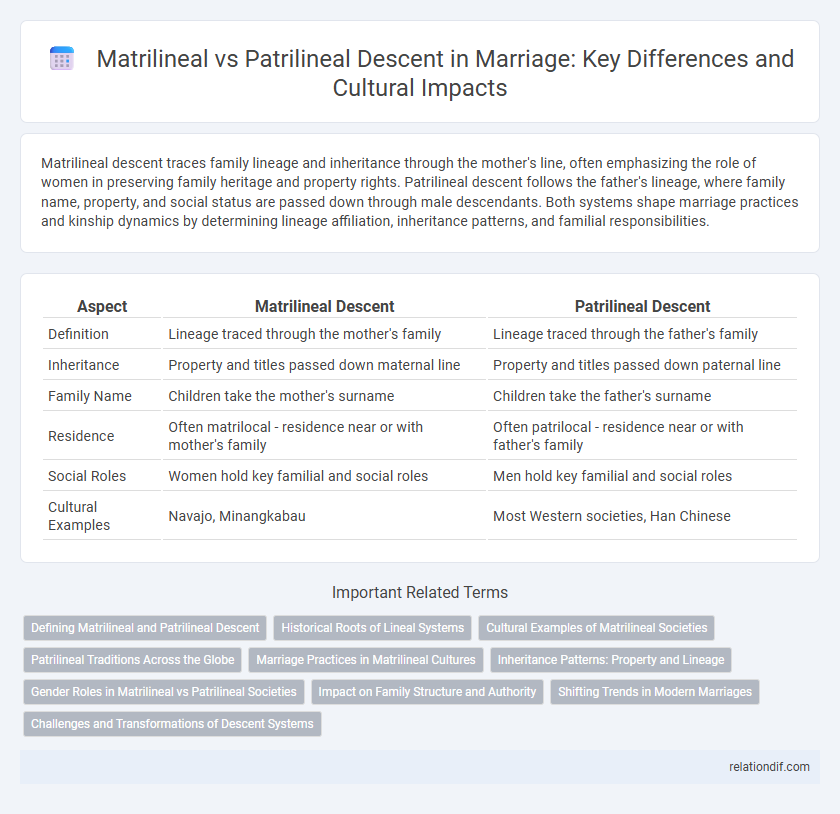Matrilineal descent traces family lineage and inheritance through the mother's line, often emphasizing the role of women in preserving family heritage and property rights. Patrilineal descent follows the father's lineage, where family name, property, and social status are passed down through male descendants. Both systems shape marriage practices and kinship dynamics by determining lineage affiliation, inheritance patterns, and familial responsibilities.
Table of Comparison
| Aspect | Matrilineal Descent | Patrilineal Descent |
|---|---|---|
| Definition | Lineage traced through the mother's family | Lineage traced through the father's family |
| Inheritance | Property and titles passed down maternal line | Property and titles passed down paternal line |
| Family Name | Children take the mother's surname | Children take the father's surname |
| Residence | Often matrilocal - residence near or with mother's family | Often patrilocal - residence near or with father's family |
| Social Roles | Women hold key familial and social roles | Men hold key familial and social roles |
| Cultural Examples | Navajo, Minangkabau | Most Western societies, Han Chinese |
Defining Matrilineal and Patrilineal Descent
Matrilineal descent traces lineage and inheritance through the mother's line, emphasizing maternal connections in determining family ties and property rights. Patrilineal descent follows the father's lineage, making paternal ancestry the primary factor in family identity and inheritance. These systems influence social structure, inheritance patterns, and kinship roles within different cultures.
Historical Roots of Lineal Systems
Matrilineal descent systems trace lineage through the mother's line, historically prevalent among societies such as the Iroquois and Minangkabau, emphasizing women's roles in inheritance and kinship ties. In contrast, patrilineal descent, dominant in many parts of Asia, Europe, and Africa, follows the father's lineage, often linked to property rights, family name, and social status preservation. These lineal systems reflect deeply embedded cultural values and have shaped marriage practices, inheritance laws, and social organization throughout history.
Cultural Examples of Matrilineal Societies
Matrilineal descent systems, where lineage and inheritance pass through the mother's line, are prominent in societies such as the Minangkabau of Indonesia and the Mosuo of China. These cultures emphasize maternal kinship ties, granting women significant social and economic influence, contrasting with patrilineal societies where descent follows the father's lineage. Understanding these cultural examples highlights the diversity of kinship structures and their impact on marriage and family organization worldwide.
Patrilineal Traditions Across the Globe
Patrilineal descent, a system tracing lineage through the male line, dominates many societies worldwide, influencing inheritance, family name transmission, and social status. In regions like the Middle East, South Asia, and parts of Africa, patrilineal traditions often dictate marriage arrangements, property rights, and kinship roles, reinforcing male authority within families. This descent pattern impacts cultural practices and legal frameworks, shaping gender dynamics and lineage continuity across generations.
Marriage Practices in Matrilineal Cultures
Marriage practices in matrilineal cultures emphasize lineage traced through the mother's side, often resulting in women maintaining residence in their natal homes, known as matrilocal residence. These societies typically assign property and inheritance rights to daughters, and husbands may have limited authority within the wife's family domain. Extended kin networks, especially maternal uncles, play key roles in child-rearing and social responsibilities, reflecting the significance of maternal lines in shaping family structure.
Inheritance Patterns: Property and Lineage
Matrilineal descent traces inheritance and lineage through the mother's side, often resulting in property and family name passing to daughters or maternal relatives. In contrast, patrilineal descent follows the father's lineage, with assets and family identity transferring primarily to sons or paternal kin. These inheritance patterns deeply influence familial roles, social status, and the distribution of wealth within different cultural contexts.
Gender Roles in Matrilineal vs Patrilineal Societies
Matrilineal descent systems assign inheritance and family lineage through the mother's line, often granting women significant authority in household decision-making and resource control, which contrasts with patrilineal societies where these roles predominantly favor men. In patrilineal societies, gender roles traditionally emphasize male dominance in political leadership, land ownership, and lineage continuity, while women typically manage domestic spheres. These differing descent structures shape gender dynamics, influencing social status, property rights, and familial obligations across cultures.
Impact on Family Structure and Authority
Matrilineal descent traces lineage through the mother, often placing women at the center of family authority and inheritance, which reshapes traditional power dynamics and strengthens maternal bonds. Patrilineal descent, by following the father's line, consolidates authority and property within male-headed households, reinforcing patriarchal control and inheritance patterns. These differing descent systems significantly influence family hierarchy, decision-making, and the distribution of social roles and resources.
Shifting Trends in Modern Marriages
Matrilineal descent, emphasizing lineage through the mother, increasingly influences modern marriage dynamics as societies embrace gender equality and women's inheritance rights. Patrilineal descent, traditionally prioritizing the father's line for property and family name, faces challenges amid rising individual autonomy and dual-income households. Contemporary marriages reflect these shifting trends, blending lineage customs with evolving social values to reshape family structures globally.
Challenges and Transformations of Descent Systems
Matrilineal descent systems often face challenges related to inheritance rights and social status in predominantly patrilineal societies, leading to shifting roles and redefined family dynamics. Patrilineal descent systems encounter transformations as increasing gender equality movements prompt reconsideration of lineage importance and property transfer. Both systems must adapt to modern legal frameworks and cultural globalization, which influence marriage patterns and descent recognition.
Matrilineal Descent vs Patrilineal Descent Infographic

 relationdif.com
relationdif.com